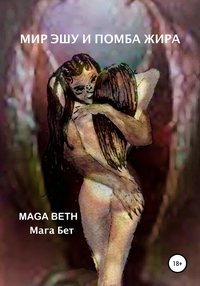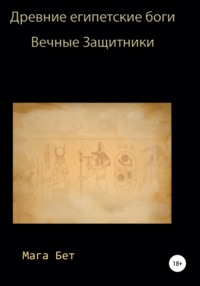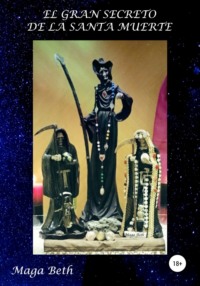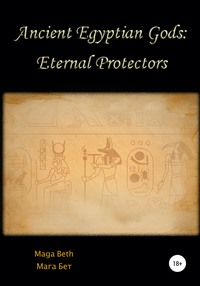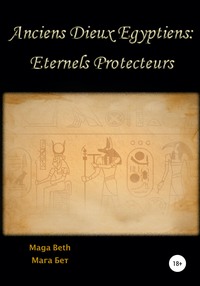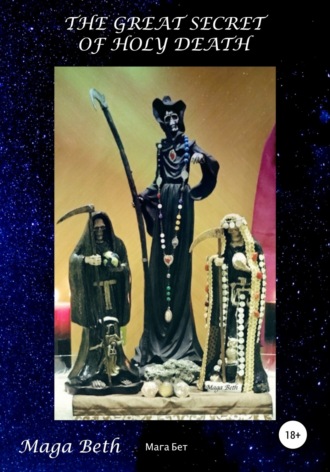
Полная версия
The Great Secret of Holy Death
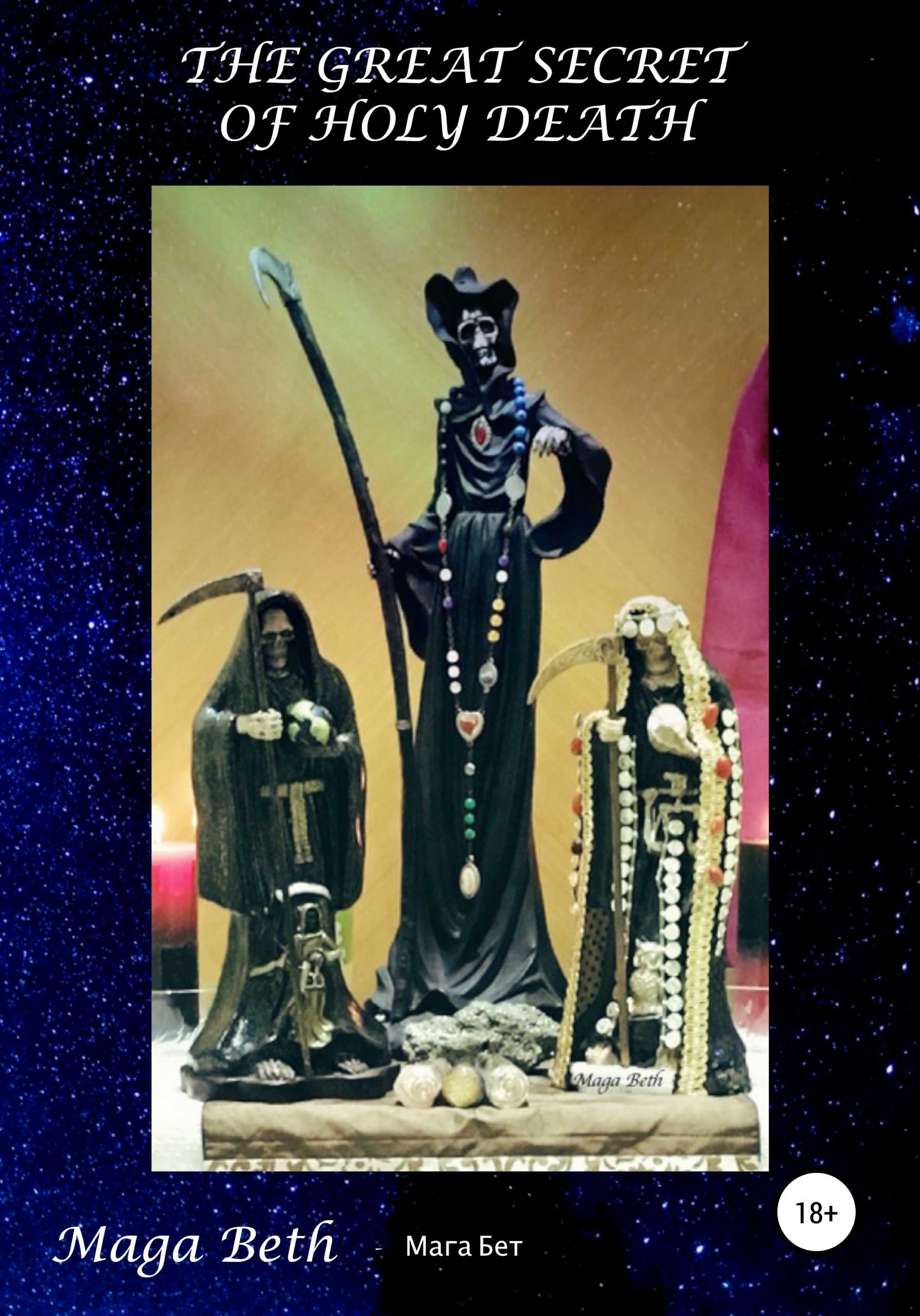
Biography
María Isabel Pedrera Pérez, better known as MAGA BETH, was born in Barcelona on February 9, 1970.
With an inherited profession, her grandmother and great grandmother introduced her in the world of High Magic; she showed, at an early age, a preference towards esotericism.
María Isabel attended basic and high school education and completed higher education with a diploma in Infant Education and Childcare, specialising her studies with the following courses:
– Educator for people with learning difficulties – Autism.
– Special needs – Dyslexia.
– Stimulation and development in education with disabilities.
– Psychopathic disorders in childhood.
– Speech Therapy.
– The teacher in school failure.
– Music therapy.
– Movement and play in the teaching practice.
She combined both studies and also specialised in parapsychology, hypnosis, occultism and astrology; and completed a Master in Quality Control and Environment.
As a good Aquarius, her restless soul led her to continue gaining experience but this time in the natural world, and earned a diploma in Naturopathy, Bach Flowers Remedies, Schüssler Salts, Dietetics and Nutrition, Lymphatic Drainage, Reflexology and Chiromassage.
María Isabel is the author of several books:
– El mágico mundo de las pirámides – Piramidología práctica y esotérica.
– Runas, símbolos mágicos.
– Diccionario de santería.
– Eshú y Pomba Gira, más allá del bien y del mal.
– El Mundo de Eshú y Pomba Gira.
– My Granny’s Potions
Throughout these years, María Isabel has collaborated in several radio programmes and esoteric fairs, has given lectures and conferences, and many Tarot, Runes and High Magic courses; and also participated in the First Congress of Mediums held in Spain.
Currently, she continues working in different fields spreading her knowledge.
Contact:
Youtube
Web
Dedication
When I discovered Santa Muerte (the Holy Death) I was in a difficult moment, I had doubts and a lack of faith. This book is the result of rediscovering myself and seeing the great treasure I have with my friends, who encouraged me to write about Santa Muerte so that people could know her in depth.
I would especially like to thank those who have translated the book so it could be read in other languages.
Also, to my family, which are those who I love and I have chosen to be in my life, those who support me and make me laugh… and live, thank you all.
Maga Beth
Introduction
What is Santa Muerte (the Holy Death)? Why are we afraid of her? Santa Muerte is the practice of a religion that originates in Mexico in which the dead are worshipped. This practice has spread to other parts of the world. It is another way of understanding faith and religion. Unknown to many and feared by others, many lies have been said about Santa Muerte and her cult. It is an ancient religion which has been passed down from parents to children.
This book aims to inform about Santa Muerte so that we lose our fear, we understand her, and we know her: the great secret and misunderstanding. We only cease fearing something when it is no longer unknown. Maga Beth with her vast experience in the esoteric world, in different religions and also in Santa Muerte, explains the cult in detail so that the reader gets to know it and demystifies all the dark and negative things that have been unfairly said about it; since every day Santa Muerte has more followers.
This work is a guide that can be used by anyone who wants to make a request, a ritual, or say a prayer, a novena prayer, for love, health, work, money, economy, family, protection, etc. As the reader will see, the ingredients recommended are simple and can be easily found in any part of the world; but, the author also provides a very simple and easy guide on how to make the ingredients that cannot be found yourself. Apart from the history and cult of Santa Muerte, this book also includes an extensive and specific compilation for every topic you may need: love, money, work, health, family, protection, etc. providing the reader with a lot of rituals, works, prayers, novena prayers, etc. for each topic.
This is another book by Maga Beth, unpublished in its sector, that will certainly leave no one indifferent.
Chapter 1 – History

The devotion and cult to La Santa Muerte (the Holy Death) is very ancient and her image has become very familiar in Mexico (where it originates) and in other countries. Many countries are debating the origin of this cult, from Mexico to Cuba, and also some African spiritualist temples (because in Africa there is a very similar, revered image called Oya). However, the truth is that nobody really knows where the belief comes from.
The Holy Death can be found on altars in the street, in shops (sometimes as merchandise, sometimes as a testimony of the trader’s faith), and in houses; along with images of other Catholic saints such as the Virgin of Guadalupe and others, which until recently were the only public manifestations of Mexican popular religiosity.
Birth and death are part of the human life cycle. We are not aware of our birth because we are babies, but the reality of adulthood makes the awareness of death a priority.
In the 1960s, the Holy Death became very popular after a villager saw her image drawn on the walls of his wooden hut at a place in Catemaco (Veracruz). He asked the priest of the village to verify the image and canonize it, but he refused. Then, the villagers decided to spread the apparition of the Holy Death from person to person, without having a place to venerate her.
In Mexico, the Aztec civilisation recognised the human life cycle which was represented by two deities: Mictlantecuhtli and Mictecacihuatl, the Lord and the Lady of Mictlan, the place where common dead went after a long and difficult journey. The temple was located in the ceremonial centre of the ancient city of Mexico-Tenochtitlan. Its name was Tlalxico, which means “navel of the earth”.

To appear before the Lord and the Lady of Death, the dead had to overcome many obstacles such as: move away from colliding rocks, cross deserts and hills, suffer threats in the form of a crocodile named Xochitonal, winds with sharp obsidian stones, a mighty river difficult to cross and ask for the help of a dog which would be sacrificed the same day of the person’s funeral (Xoloitzcuintli).
Some of these pre-Hispanic beliefs are still latent in Mexican popular culture, such as November 2nd or the Day of the Dead, when they celebrate the day of their deceased ancestors. The idea is to remember the dead with joy, just as they lived in life, and not with the sadness and grief of their death; it is very popular to bring music to funerals to dance and brighten the departure of the dead. Death is seen as a suffering being with a very painful job, which was given a great power but also a great burden that nobody sees.
Mexicans also had other representations of death; such as tzompantli or “skull rack”, rows of wooden poles used to display human skulls, as in the abacuses. These “skull racks” were found in the great temples of Ancient Mexico and were considered an important part of the cult of death. Death could also be represented by skull figures carved in stone, in clay, or skulls beautifully painted. Human skulls decorated with flints and shells instead of eyes have also been found. The experts have not agreed on the meaning of these skulls, but they assume they were some sort of offering to the lords of death. Traces of stark death, ornso be it’s of the Goddess Coatlicue, offerings in ritual incense burners, and figures of all types and sizes have also been found.
This indicates that there was a very strong cult towards death among the ancient Mexicans, and also among the Mayans, the Tarascans and the Totonacs, who also had a great devotion to death.
Then, the Spanish arrived and it was thought that the cult to death would be forgotten, but that was not the case: Mictlantecuhtli and Mictecacihuatl (mainly the latter) remained hidden and many of their devotees continued following them.
In his study on the Holy Death, the archaeologist Carlos Navarrete suggests that the popular devotion could be due to the syncretism between a Christian deity related to death and Saint Pascual Baylon, a Catholic saint and the Animas Solas (Lonely Souls).
The Spanish Conquest was imposed by “blood and fire” on the indigenous people of Mexico, but there were also another conquest: the spiritual one, which was the total destruction of the divinities that made up the indigenous culture. However, despite all their efforts, some traces of the ancient religion still remained within Catholicism and the cult to the Holy Death is part of that distant past.
The conversion of the indigenous peoples was paramount for the Franciscan missionaries, and the resistance of the natives towards the new religious doctrines was a permanent condemnation for evangelisers. The malpractice of some indigenous people was denounced in a text written in c. 1600 which mainly described the idolatries in the small village of Tuxtla.
The only true God for Catholics was the one that was established in the Bible. Therefore, when they found another religious thought, they condemned it as if it was a satanic rite: but this was unfair since in Ancient Mexico the concept of hell was not known. The indigenous gods were venerated in pyramids, in hills and in caves, and during the first years of evangelisation the Catholic missionaries did not understand why people used to dance around bones (which had often belonged to high priests or leaders, and that was why they worshipped them). These were only some of the religious practices of the time, which were beyond the comprehension of the minds of conquerors and evangelisers.
To try to hide these practices, the faithful devotees of Mictlancihuatl most probably “dressed” the cult of this goddess with elements of Catholicism to avoid being punished. The mixture of both roots -Indigenous and European- and the addition of Creole elements gave rise to the cult of the Holy Death, as we know it today.
The current and contemporary cult of the Santísima Muerte (Most Holy Death) appeared in Hidalgo around 1965. And it is rooted in the states of Mexico, Guerrero, Veracruz, Tamaulipas, Campeche, Morelos and Distrito Federal (in the “barrio de Tepito” the cult is commonly used among criminals and merchants), Nuevo Leon, Chihuahua, Quintana Roo, Oaxaca, Tijuana and Guanajuato. It was integrated with the cult to Tonantzin (female deity for the natives and later syncretised in the Virgin of Guadalupe) and that of the Virgin Mary.
The Holy Death is a spiritual entity, an image, a soul that helps and protects anyone who comes to her to ask for favours. She does not work under any kind of magic, neither white nor black. It has sometimes been said that the Holy Death is sinister, painful, cruel and cold, but this is not the case.
Devotees to the Holy Death report that among other favours, she can grant miracles to those who venerate her. Her worship has also been associated with criminals, prostitutes and drug dealers. People living in modern cities and villages also invoke her protection. However, people who live in situations of high risk are usually the ones who venerate her the most, wearing medals or images of the Holy Death or even a tattoo in their skin. Her image can be found mainly in soldiers, policemen, drug dealers, criminals and prostitutes. The Most Holy Death is a symbol that represents people living between the legal and the illegal, but her cult can also be found in the highest strata of society.
People ask her for anything: health, love, good luck, to recover stolen objects or even kidnapped relatives, for business, to open new roads, to win trials, to ward off bad neighbours, to protect vehicles from accidents and thefts, to have more money, to recover debts that people owe us, to find work, to bring food into the home, to ward off harmful friends from your partner or loved ones, to increase love in our partner, to forget a love, to regain a love lost, for matrimonial attraction, to ward off the lover of your partner, to make it up with your partner, for abundance, etc. Several rituals and special prayers are used to approach the Holy Death and gain her favours.

It is said that when the Holy Death grants a favour, one of our relatives must pay for it. This is absolutely false, since she protects the family from illnesses caused by works of black magic, witchcraft or natural disease. It is also said that she punishes you if you do not give her penances. This is totally false too, since she works to help her devotees and not to punish them. We must ask her with faith and kindness, with all our heart and without trying to hurt anyone: respect, faith and devotion from the heart for the Most Holy Death. No matter how difficult a problem may be, the Holy Death will help us without asking for anything in return, but if you offer her something you must give it to her wholeheartedly.
Every day the Holy Death has more devotees and the jealous Church does not see this with good eyes.
It is important to know that by asking the Holy Death, you unleash great forces which magnitude and power must always be handled with a lot of respect and faith. A misuse of everything revealed in this book, is the responsibility only of those who misuse them. If you decide to use them for the dark side, sooner or later they will revert to you for evil, making you guilty for yourself.
Normally, the images of the Holy Death and her cult in general are treated with sincerity and for offering company, something very different from the usual fear of religious rituals. The thing is to treat the image as a member of your family and to appear before it without fearing or disrespecting her.
It is said that once, a sanctuary where the Most Holy Death was being worshiped disappeared because it was annoying some people. To avoid this, believers have different options: hide her image, or replace it with a white rose.
As a curiosity, there is the famous image of Jose Guadalupe Posadas called La Catrina that is currently in prints, small paper cards, chains, rings, medals and figures of bulk of different shades and sizes.
There is a legend that emerges from her, in a place called San Pantaleón. In this place hundreds of people professed their faith in this image, which apparently had been destroyed in a fire ironically caused by a candle that one of the worshippers lit for the image. In that same town, another loyal devotee made a new image using a wooden log and placed it near the temple where people worshipped the image and showed their devotion every July 27. The inhabitants of the town carried small figures of the Holy Death round their necks, and worshipped the image with absolute faith in their houses. The miners entrusted themselves to the Holy Death before going down to the mines, so that day after day she would bring them back to their houses and there would be no tragedies. Every day she had more devotees because the people’s petitions were heard. After some time, the production of minerals stopped and the people left the town. Nothing was ever heard about the image they worshipped.
During my visit to Mexico I heard about a person with great devotion: Mrs. Enriqueta Romero Romero. Everything people explained me about this woman (although I could not meet her personally) was kindness and love. She was the founder of the first shrine to the Holy Death, and she assures that her worship is not related to any kind of witchcraft, sorcery or Satanism. On her altar people only pray, ask and make offerings to La Santísima (the Most Holy).
Her parishioners are Catholic and in their demands and prayers God, Christ and the Virgin of Guadalupe are always invoked, ‘because the Most Holy is no stranger to the Christian religion’, although the Catholic Church does not recognise her cult. The shrine of the Holy Death is placed in front of her house, surrounded by floral and fruits offerings (mainly apples, which symbolize abundance), votive offerings, candles, toys, notes, coins, sweets, cigarettes, cigars, alcoholic beverages in glasses and bottles.
In this place, the sculpture of the Most Holy -also called Señora de las Sombras (Lady of the Shadows), Señora Blanca (White Lady), Señora Negra (Black Lady), Niña Santa (Holy Nina), La Parca, La Flaca (The Skinny) – is two metres high. Her traditional figure is the skeleton of the Day of the Dead, but dressed as a virgin and saint with different coloured costumes, each of which has a special meaning. Bracelets of pearls, gold and silver with embedded gemstones hang from her neck, clothes, scythe, scale, metal arms and phalanges. These are offerings and gifts of those who thank her for some miracle or favour.

For over 40 years, the Romero family has been worshipping the Most Holy and they state that she does not care about the social or work background of her worshippers. People of different social conditions, as well as children, old people and women of the streets go to Alfareria Street, number 12.
Her worshippers change the clothes of the Holy Death every first Monday of the month; the colour is in accordance with the season and with the demands of her devotees. Red symbolizes love and passion; green, hope; white and blue, peace and pureness -the colours of the virgin Mary- because she usually wears these colours.
The feast of the Holy Death is on November 2, the Day of the Dead and the night before, on October 31, the devotees pray a rosary to dress her in white as a bride. Nocturnal rosaries take place on this day and on Mondays of every month to bless the images carried by her devotees. The people who visit her altar feel the same devotion as they do before Christ, the saints and the virgins; they cross themselves, they pray, they ask and they make offerings. The number of followers grows day by day; when the rosaries are prayed, the streets close to Alfareria Street are closed.
Sellers of all types gather around the ceremony: soft drinks, flowers, candles, figures of the Most Holy, clothes, leaflets with engravings and specific prayers for the rosary, and cigars, which apparently are what the Nina Blanca prefers.
Leonor Paredes, the aunt of Mrs. Romero, instilled this cult and began to practice it in 1962; however, evidence suggests that the devotion to the Holy Death probably dates from the 19th century, when shamans in Catemaco also paid homage to her for a long time.
Amongst the most frequent prayer requests made to the Holy Death is that of keeping the fidelity of the couple. There is a legend saying that the Holy Death was a woman who lived in Pre-Hispanic times and was deceived by her husband. The pain she felt when she saw her husband in the arms of another woman was such that she committed suicide. When God saw her suffering, he made her the patron saint of marriages. This is why she is now the protector of marital union, and she can do a lot of harm to an unfaithful husband, if his wife asks for it. For these same reasons, people ask the Holy Death for help so that one person feels attraction to another and they get married.
As the Señora de la Noche (Lady of the Night), she has a special preference for people who work once the Sun has set because of the dangers they are exposed. She helps taxi drivers, mariachis, bartenders, police officers, soldiers, waitresses, prostitutes, etc. She is the patroness and the defender against assaults, road killings, wounds by firearms, and against all types of violent death. It has been reported that she has prevented the death of devotees involved in road accidents.
You may also ask her for things that you would not dare to ask other saints, for example: the death of your enemy, rival or unfaithful partner; damage to the properties of those who feel envious or resentment, or make that all evil they have sent towards us turns against them. She is considered a righteous entity, since she does not grant whims, but gives everybody what they deserve. Therefore, her devotees are asked to live a righteous life and fulfil the promises they make to the Most Holy.
Chapter 2 – Why is the worship of the Holy Death Expanding?
To answer this question you are going to understand me very easily. Almost all of us come from religions that threaten or suggest that things will go wrong if we act or think badly.
At some point in our lives, we have all been angry, we have all screamed or we have all said something in a moment of heat. This is part of human nature.
What difference is there with the cult of the Santisima Muerte (the Most Holy Death), La Nina Bonita (the Pretty Girl), La Flaca (the Skinny), La Flaquita (the Skinny Lady), La Santa Patrona (the Patron Saint), la Catrina…?
Well, you can ask for anything and we all, basically, deserve to have the same help without any difference, without judging our past, or what we have done; you must only look forward: it does not matter if you are a peasant or a king.
We all have a common moment in our lives in which we know we must cross the line without the certainty of knowing where we are going.
If all our material possessions were taken away and we were told that we had to go, that the hour of our death had arrived… the first thing we would do would be to take care of our loved ones, and we would put everything in order in one way or another. But, what none of us would forget then, is that the most important thing is to have a good death, a peaceful death and with no pain.

Since the Most Holy Death helps and protects everyone she has been wrongly labelled, for a short time, as something negative.
The people who ask and pray to her have found great relief and consolation and that is why her worship and spreading is done through her own devotees, transmitting the cult orally from parents to children.
Chapter 3 – The representation of the Holy Death and its forms

The Holy Death may be represented in different ways, as a male or a female figure; as a masculine figure, it is gloomily dressed and has a scythe and a rosary; as a feminine figure, it is dressed in a long white satin robe and has a golden crown.
The Holy Death may also be represented as a skull, a skeleton covered with a robe, sometimes holding a scale -which means equality for all- or with a scythe, as an elderly woman or as a pretty young woman, dressed in white, in black, in red, in yellow, or in other colours, or also as a man in humble clothes.
The most frequent representations are in prints, either in black and white or in colours. They are made of resin, glass, metal, papier-mâché, wood, bone, etc., and consecrated according to the person who makes them.
The Holy Death sitting
The Holy Death is sitting on a kind of throne watching the world, and is a faithful servant of the Universal Creator. The figure is holding a scythe or a balance (with which the world is balanced between the spiritual and economic side), and is accompanied by an animal that represents the underworld, such as the owl. In the other hand, there is a scythe which represents the mutilation of all negative energy, wherever this figure is placed. For Law Offices, the ideal colour is green.
Sitting on the world
The strength of this figure is in the orb, it is used more as a reference to its strength than as a special form for making requests. It is used with other images. The head tilts upwards indicating that the Holy Death always looks like this at the Creator of all visible and invisible things. This position suggests that the Holy Death will always be His faithful servant and that of all existing things. This figure is always dressed with a robe and is holding a scythe, which symbolizes the tool needed to cut all bad energy that affects the human beings.




